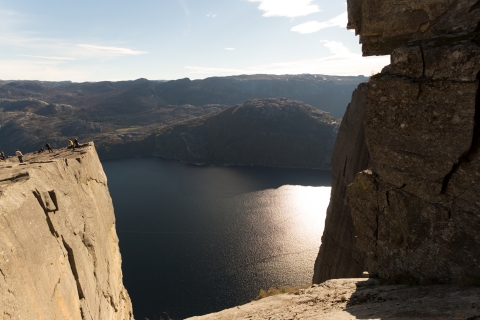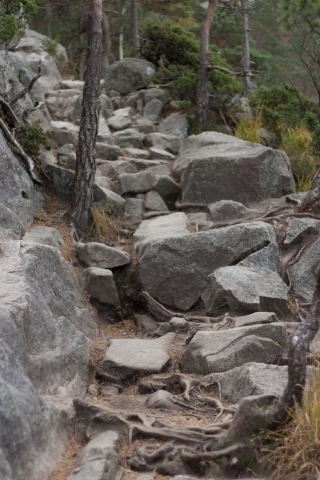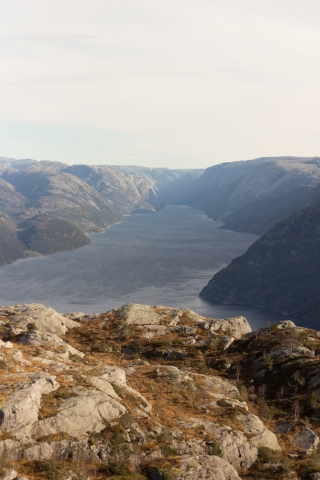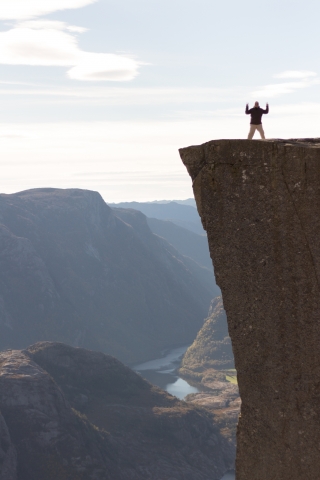
Dec 19, 2016
Climbing Mountains, Embracing Technology: Living with Acoustic Neuroma
Written by: Nick Kucharew (Fox River, NS)
Part 1: A Little Off Balance but Not Out of Step: Nick's Hiking in Norway
Posted: December 19, 2016
Over three years ago I had acoustic neuroma surgery to remove a moderately large tumour. The surgery was very successful with complete removal of the growth and only some minor issues afterwards. Aside from hearing difficulties that I continue to struggle with, I also have issues with my balance. Sometimes my balance seems normal, while other times I wonder why I just don't go lie down!
I keep persevering with my balance issues although it is somewhat scary at times. I bump into walls, miss steps, stumble, and fall the odd time, but I do keep on going. A year or so ago, I was up on the extension ladder and my wife said I started to sway backwards suddenly. She thought I was going to fall. It scared the dickens out of her, but I managed to grab the rung before anything happened. Scared me a bit too!
So about my trip to Norway...
My wife and I began planning a three-week trip. The first week was going to be spent driving from Oslo to Bergen. The next two weeks would be a cruise along the Norwegian coast - all the way to the top and back. Pretty nice, huh?
As we were figuring out our trip in more detail such as driving routes, accommodations, and sights along the way, we became really interested in going to Pulpit’s Rock (Preikestolen). This is a very famous mountain location in Ryfylke that towers 604 meters over the Lysefjord. People come from all over the world just to see this place. It is a huge flat plateau, just over 2,000 feet above the fjords with water below, and the only way to get there is to hike up the mountain. The view would be amazing.

So we began planning our own once in a lifetime visit. Early on, my wife asked me if I was okay to do something like this. I conveniently forgot about my balance issues and replied, "Sure, why not?"
As our trip was planned for the off-season when there was the potential for cold and wet weather, we thought a guide was the only way to do this safely. We hired a guide from a company in Norway that specialises in this kind of thing. It wasn’t cheap, but we didn't want to go on our own. We knew this made the most sense since we were not familiar with the area or the terrain.
Getting closer to our departure date, I started to investigate Pulpit’s Rock more and more. I watched videos and tried to get a good feel for what I was getting into. When I saw the pictures and the videos, I started having second thoughts! What the heck was I thinking! It looked dangerous in many parts, and I was really getting concerned about my balance. I only had to make one small misstep, and I'd be in big trouble!
One section near the top appeared very narrow with a steep drop-off all the way down. And I couldn't see in the pictures and videos if there are any supports! My mind was racing as I tried to imagine if I would be able to pass that spot. I was getting more and more worried and contemplated cancelling this dream of a hike. I worried about it for days. I spoke with my wife and eventually she agreed to cancel, even though we would lose the upfront payments.
It would hurt me to disappoint her. This was a dream for her too! So we decided that we would figure out some sort of solution!
After quite a bit of discussion, my wife and I arrived at a plan that we hoped would work. We outfitted ourselves with some hiking gear - backpacks, walking poles and hiking boots. We decided to train for our Norwegian hike by going on treks near our home. This allowed me to practice, practice, practice, and either find out if this dream was a possibility, or not.
With about six weeks before we were due to leave, there really wasn't a lot of time! But better late than never.
The first weekend we noted that the hike did not look terribly difficult. As we continued to walk up hills and over rocks, I discovered my balance was actually BETTER than normal. What gives? Maybe the ground was so uneven and rocky that it was offsetting my imbalance? Who was I to argue?
Over the next six weeks, we hiked and hiked and hiked, as much as we could. We wanted to get used to the rougher terrain while carrying all the weight from our gear in our backpacks. We were bringing cameras, a tripod, wind jackets, extra clothes and water. We needed to be prepared. Our hikes were all okay. And we got a lot of exercise too!
Now on to Norway and Pulpit’s Rock!
We left our hotel early in the morning, before 7 am, travelled by ferry and then drove to the base of our climb.

Here is a picture near the beginning to give you some idea of what we were climbing/hiking up. The climb to the top went well. The preparation and training were well worth the effort.
After 3 or 4 hours, we reached the top.

This is what we saw. Pretty nice.
After only a few minutes I decided I had to go close to the edge, lie down and look over, straight down to the water. Previous to the trip there was NO WAY I could even imagine being near the edge. I didn’t think I would be able to do it. I was nervous that a gust of wind would hit me, I'd lose my balance and get tossed over!
I also climbed up here so I could get some more pictures.
It took us another 3 or 4 hours to descend a back-route that very few people know about. Fortunately, our guide had hiked this area for many years and knew the trails that would work best for my needs. Hiring a guide was, in the end, one of our best decisions.
The entire trek took us almost 8 hours - to go up and back down. It was the most gruelling hike we could have ever imagined. We were exhausted and very sore for a few days afterwards.

But it was worth it. Let me tell you. It was worth it!
I was also extremely happy that I worked up the courage to go to the edge. It was something I never thought I could do, but I did with enthusiasm. That alone has given me a bit of a reputation with my wife as a "Wild Man."
As a final send off to our adventure, here is a picture I shot at the end of the trip when our ship was in a harbour after a storm. Can you see the double rainbow? My wife said she saw a triple.
So here I am looking over the edge for about a minute and a half, while the guide took these pictures. My wife is just behind me. I think she was going to grab my legs, just in case.
I also climbed up here so I could get some more pictures.
It took us another 3 or 4 hours to descend a back-route that very few people know about. Fortunately, our guide had hiked this area for many years and knew the trails that would work best for my needs. Hiring a guide was, in the end, one of our best decisions.

The entire trek took us almost 8 hours - to go up and back down. It was the most gruelling hike we could have ever imagined. We were exhausted and very sore for a few days afterwards.
But it was worth it. Let me tell you. It was worth it!
I was also extremely happy that I worked up the courage to go to the edge. It was something I never thought I could do, but I did with enthusiasm. That alone has given me a bit of a reputation with my wife as a "Wild Man."
As a final send off to our adventure, here is a picture I shot at the end of the trip when our ship was in a harbour after a storm. Can you see the double rainbow? My wife said she saw a triple.

Part 2: Bridging the Gap: Nick's Road to Enhanced Hearing
Posted May 15, 2020
My story begins in 2011 when I discovered I had an acoustic neuroma. I suddenly lost my hearing in the right ear. Next came an MRI, appointments at Sunnybrook Hospital, and the decision to Wait and See . . .
In September 2014, I had surgery to remove the tumour using the translabyrinthine approach. The result, successful removal!!! However, this meant that my balance nerve* was also removed, and I was left with single-sided deafness [a necessary result of translab surgery].
Jump forward to early 2015: after researching various options to help with my lost hearing on the right side, I came across the Bonebridge Bone Conduction by Med-EL. The Bonebridge, an active bone conduction implant, is inserted under the skin on the tumour side of your head, and an external SAMBA audio processor is magnetically coupled to the implant’s coil.
How Does it Work?
In a person with normal hearing, sound vibrations are sent through the outer and middle parts of the ear and on to the inner ear.
If you have single-sided deafness like me, the BONEBRIDGE can pick up the sound vibrations on your bad side and send them through to your inner ear on the good side. This results in much-improved hearing on the damaged side.
The system consists of the SAMBA Audio Processor and a Bone Conduction Implant.
Click to see a video that illustrates how it works
The audio describes conductive or mixed hearing loss, which is where your outer (or middle ear) is damaged, but your inner ear to hearing nerve is intact. As I had single-sided deafness and my inner ear to the hearing nerve was not intact, sending the signal to the damaged side’s inner ear would not work. But it does work when sent to the inner ear of the “good side”, which has an intact inner ear to hearing nerve connection.
What Does This Mean for the Wearer?
The Pros
I would like to note the BONEBRIDGE Bone Conduction Implant surgery I had in 2015 was a quick one, about one hour. It went very well with no ill side effects.
I remember driving home with my wife, and we decided to stop for lunch at my favourite breakfast place. It was EXTREMELY noisy and normally that would have hurt and been intolerable. I sat there and could not believe how well I was handling the noise all around me. That is a most welcome benefit of the implant with an audio processor.
The other thing I noticed after months of wearing it was that I was not as tired by midday. As many of you know, when you are deaf on one side, trying to hear people talking and make out what they are saying is very tiring. It was significantly better with this device.
Also, the device attaches easily as it has a simple magnetic coupling, and the implant is completely under the skin, so no infections, irritation, and so forth. Batteries are about 25 cents apiece, last a week, and are easy to replace.
Finally, the audio processor can be upgraded. This is a particularly nice benefit as new features, better processing, etc., become available. Although the device is not perfect, it is comfortable, works well in picking up sounds and pretty good overall.
The Cons
The biggest downside I find is that while the Bonebridge picks up sound on my deaf side, the volume I get is perhaps 20% or so. I wish it were closer to the volume I hear on the good side.
Sometimes it has fallen off, even with the safety clip, and at a cost of approximately $5500, you do not want that happening too much!!
The audio processor is capable of using wireless and Bluetooth, but through another external device, the Siemens MiniTek. I found it worked well with some things such as a personal mic headset my wife wears and listening to the TV with a transmitter attached. But, all in all, it is more trouble than it is worth to continually set up the equipment to make it work. Needless to say, I don’t use it that way much anymore.
Wearing the device with hats is somewhat problematic as you must play with the fit of your hat, and usually, there is still some feedback, which can be a bit bothersome. You also need to be careful to not wear it into the shower, swimming, etc. I have got it wet on occasion and, fortunately, it held up quite well.
The Net Results
In summary, the Bonebridge has allowed me to handle day to day life much better. I am less tired, have better speech discrimination, and I’m much better able to handle noisy environments.
Note: Determine what support is available for hearing devices in your province from an audiologist/hearing devices specialist.




